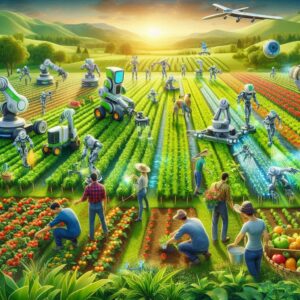In recent years, the agricultural sector has undergone a technological revolution, with robotics at the forefront. These innovations are addressing challenges such as labor shortages, rising food demand, and the need for sustainable farming practices. From automating labor-intensive tasks to optimizing resource use, robotics is reshaping the future of agriculture and farming.

Introduction: The Role of Robotics in Agriculture
Agriculture has always been a labor-intensive industry. However, with advancements in technology, robotics is offering farmers a more efficient, precise, and sustainable way to grow food. By reducing dependency on manual labor and minimizing resource wastage, robots are helping farmers meet modern agricultural demands while addressing global food security.
1. Automating Farming Tasks
Robots are now handling repetitive, labor-intensive tasks with speed and accuracy, freeing up farmers for more strategic decision-making.
Key Applications:
- Planting and Seeding: Robotic seeders ensure precise placement and spacing of seeds, optimizing growth potential.
- Weeding: Weed-removal robots use advanced sensors to identify and eliminate weeds without harming crops.
- Harvesting: Robotic harvesters can pick fruits, vegetables, and grains faster and with less damage than human hands.
By automating these tasks, farmers save time, reduce labor costs, and achieve higher yields.
2. Precision Agriculture with Drones and Sensors
Precision agriculture leverages robotic technologies like drones and sensors to optimize resource use and enhance productivity.
Key Innovations:
- Drone Monitoring: Drones equipped with cameras and sensors collect real-time data on crop health, soil conditions, and irrigation needs.
- Soil Sensors: Embedded sensors monitor moisture levels, nutrient content, and temperature, enabling targeted irrigation and fertilization.
- Data Analysis: AI-powered analytics provide actionable insights to maximize crop growth while reducing waste.
This data-driven approach minimizes resource usage while boosting efficiency and sustainability.
3. Livestock Management Made Smarter
Robotics isn’t just transforming crop farming—it’s revolutionizing livestock management as well.
Key Innovations:
- Milking Robots: Automate the milking process, ensuring consistency and reducing stress on animals.
- Health Monitoring: Wearable sensors and monitoring robots track animal health and behavior, alerting farmers to potential issues early.
- Feeding Systems: Automated feeding robots distribute the right amount of food based on individual livestock needs, minimizing waste.
With these technologies, farmers can improve animal welfare and productivity.
4. Sustainable Farming Practices
One of the most significant impacts of robotics in agriculture is its ability to promote sustainability.
How Robots Help:
- Water Conservation: Precision irrigation systems powered by robotics deliver water only where it’s needed.
- Reduced Chemical Use: Robots can apply pesticides and fertilizers with pinpoint accuracy, reducing harmful runoff.
- Carbon Footprint Reduction: By optimizing energy use and reducing waste, robotics helps lower the overall environmental impact of farming.
Through sustainable practices, robots are helping create a balance between productivity and environmental responsibility.
5. Addressing Labor Shortages
The agricultural sector has long faced labor shortages, especially during peak seasons. Robotics offers a solution by taking over labor-intensive tasks.
- Year-Round Assistance: Robots work tirelessly without breaks, ensuring consistency in farming operations.
- Flexibility Across Tasks: From planting to harvesting, robots can handle multiple functions on the farm.
This not only bridges the labor gap but also ensures that critical tasks are completed on time.
Conclusion: A New Era of Farming
Robotics is transforming agriculture into a more efficient, sustainable, and innovative industry. By automating labor-intensive tasks, optimizing resource use, and promoting sustainability, robots are helping farmers tackle modern challenges head-on. As technology continues to evolve, the agricultural sector will reap even greater benefits, paving the way for a future where farming is smarter and more productive than ever.
